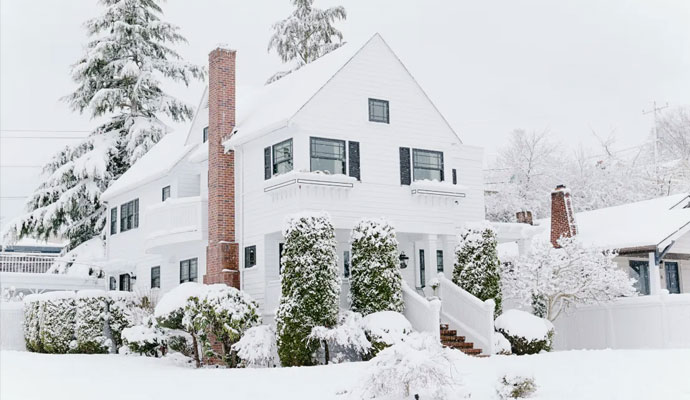Winter can be beautiful, but it can also be tough on your home. As temperatures drop, heating costs rise, and issues like drafts, ice dams, and frozen pipes can make this season challenging. With a few simple steps, you can prepare your home for the cold months ahead. Here are five essential tips for winterizing your home to keep it cozy, safe, and energy-efficient all winter long.
1. Seal Drafts and Insulate Your Home
Drafts are one of the biggest causes of heat loss, which can significantly increase your heating bill. Here’s how to keep the warmth in and the cold out:
- Seal Windows and Doors: Use weatherstripping and caulk around windows and doors to seal any gaps. Draft stoppers on doors can also prevent cold air from sneaking in.
- Add Insulation: Insulate your attic, basement, and any exterior walls. Insulation helps retain warmth and reduce heating costs.
- Check Outlets and Switches: These areas can let in cold air. Insulate behind outlets and switches, especially on exterior walls, to block drafts.
2. Prepare Your Heating System
Before winter hits, make sure your heating system is in top shape. This can save you money, reduce the risk of breakdowns, and ensure your home stays warm throughout the season.
- Get a Professional Inspection: Have your furnace or boiler serviced by a professional to ensure it’s running efficiently and safely.
- Replace Filters: Dirty filters make your system work harder, increasing energy usage. Replace filters monthly during the winter to keep your system running smoothly.
- Test Carbon Monoxide Detectors: Heating systems can emit carbon monoxide. Make sure you have detectors installed on every floor, and check batteries regularly.
3. Protect Your Pipes
Frozen pipes are a common issue in winter, and they can burst, causing expensive water damage. Take these steps to protect your pipes:
- Insulate Exposed Pipes: Wrap insulation around pipes in unheated areas like attics, basements, and crawl spaces.
- Let Faucets Drip: In extreme cold, keep a small trickle of water flowing through faucets to prevent freezing.
- Seal Gaps: Check areas where pipes enter the home. Gaps can let in cold air, so seal them to reduce the chance of freezing.
4. Clean and Inspect Gutters and Roof
Winter weather can be hard on your roof and gutters, and ice dams can form if these areas aren’t properly maintained.
- Clear Out Debris: Clean your gutters to ensure they can handle winter precipitation. Clogged gutters can cause ice dams, which can lead to roof leaks.
- Inspect for Damage: Check your roof for any loose or missing shingles. These can lead to leaks, which can cause costly water damage.
- Install Gutter Guards: If you live in a particularly snowy area, consider adding gutter guards to prevent ice and snow from clogging your gutters.
5. Upgrade Your Windows and Curtains
Windows are one of the biggest sources of heat loss in the winter, but there are easy ways to boost their insulation.
- Add Window Film: Heat-shrink window film creates an additional insulating layer. It’s easy to install and can keep your home warmer without extra heating.
- Use Heavy Curtains: Switch to thermal or heavy curtains to keep the heat in. Draw them at night and during especially cold days to help retain warmth.
- Install Storm Windows: If possible, install storm windows on older windows. This can drastically reduce drafts and make a noticeable difference in heat retention.
Final Thoughts
Winterizing your home may take a bit of time and effort, but it’s well worth it. These steps not only help keep you warm and comfortable but also prevent costly repairs and reduce energy bills.
4o

